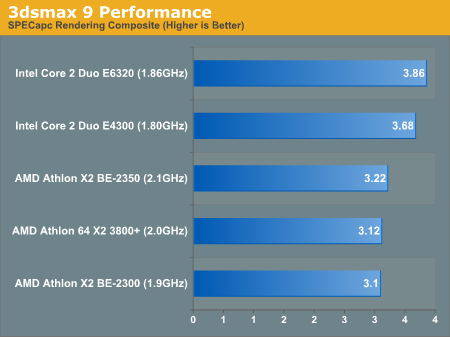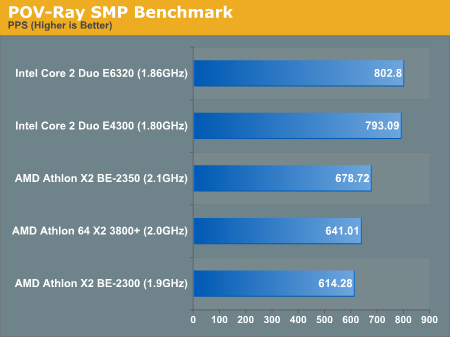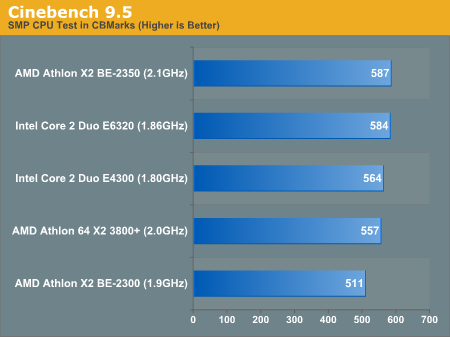AMD Athlon X2 BE-2350: Mainstream X2s with 45W TDP
by Anand Lal Shimpi on June 5, 2007 4:09 PM EST- Posted in
- CPUs
3D Rendering Performance
Our 3dsmax 9 test scenario is still made up of the CPU rendering tests of the SPECapc 3dsmax benchmark. We report the rendering composite, which is simply the geometric mean of render times across seven benchmarks normalized to a set of reference scores.

POV-Ray's ray tracing benchmark has been a popular CPU test for quite some time, and we turn to its SMP beta to stress the CPUs here today (we use the sse2 binary):

Our final 3D benchmark is the 32-bit version of Cinebench 9.5, a fairly popular 3D rendering benchmark due to its ease of use and quick runtimes. We ran the multi-threaded CPU rendering test and reported the final score in CBmarks. Higher numbers are better:











46 Comments
View All Comments
lopri - Tuesday, June 5, 2007 - link
Then why didn't you include Pentium D's in the charts?Anand Lal Shimpi - Tuesday, June 5, 2007 - link
I mentioned the Pentium 4 based processors on the front page in this quote:"While you can get older Pentium 4s for less than $100, you wouldn't really want to from a power and performance standpoint."
We've always recommended the X2s over the P4s, thus the real question is how big of a gap is there between these X2s and the lowest end Conroes.
Take care,
Anand
lopri - Wednesday, June 6, 2007 - link
You're mixing things up. I do understand where your argument is headed, but unfortunately the presentation isn't exactly relecting your intention.dm - Tuesday, June 5, 2007 - link
It overclocks well (http://fanboyreview.blogspot.com/2007/03/brag-anot...">http://fanboyreview.blogspot.com/2007/03/brag-anot...And the best thing is, it should be really affordable ;)
Spoelie - Tuesday, June 5, 2007 - link
What was the point of increasing the latency of the L2 cache for the 65nm process if AMD isn't increasing cache size?? Now, as proven in this article, we have situations where 2ghz 90nm parts are outperforming 2.1ghz 65nm parts, and the K8 is in dire need of any performance it can extract.Sometimes I think AMD is doing it on purpose, they're now at a point where I'm starting to lose confidence in any sort of comeback. Underperforming r600, delayed barcelona, delayed agena, delayed hd2600xt, initial reports on all upcoming parts "disappointing", process technology 1+ years behind Intel. Way to piss away your 3 years head start with hammer AMD.
I know this is the kind of post that gets downrated but as a long time ATi/AMD believer, the bad news just keeps piling up.
TA152H - Tuesday, June 5, 2007 - link
Because, AMD will probably increase the cache size in the future. They indicated this earlier. Even now, it probably increases yields a little, and thus allows lower costs. I'm not sure where the bottleneck is on AMD processors though, but you probably remember the Coppermine and the problems it had getting over 1 GHz. Actually, Intel did release a successful Coppermine at 1.1 GHz, but it was a Celeron. This is because the problem was with the L2 cache not being able to hit the higher clock speeds. Considering this, and the fact AMD did add wait states to the cache in the event they increase the size, it is very possible this is improving yields.AMD never had a three year advantage over Intel. Intel mobile chips were always better in power/performance than anything AMD, just as the Pentium III was. The Athlon and Athlon 64 were not particularly good chips, it was just they were competing against a particularly bad chip (P7, of course), and when Intel ditched it, naturally things got worse for AMD. Also, The P7 was way ahead of the Athlon 64 in technology. It was a much more advanced chip, so even in that regard the Athlon 64 wasn't ahead. Granted, it worked better, but it was a much more prosaic design.
Calin - Wednesday, June 6, 2007 - link
Pentium !!! might have been better in performance per power, but was worse in performance per clock (performance per power was a metric hardly used back then on desktop).The K7 chips (first Athlons) were faster clock-per-clock than Pentium !!! (the 100MHz FSB Pentium !!!) by at least a little. Also, the Athlon64 were better than the AthlonXP it replaced.
True, the Pentium4 C were very good chips, even compared to Athlon64 (teh 2400MHz were very good). Too bad the 2MB cache P4 chips were even worse than the Northwoods per clock, and could not scale in frequency.
TA152H - Thursday, June 7, 2007 - link
The Coppermines were better per clock than the Athlon in most benchmarks except pure x87. Read some old articles if you don't know that. Considering they were much smaller, and used much less power, and had terrible memory bandwidth, this clearly shows what a bad design the K7 was. It was mainly because of the better OoO scheduling of memory loads, although the fast L2 cache helped some (mainly because the memory bandwidth was so poor, and the L1 cache relatively small). The K7 was bigger in almost every way, and had much better memory bandwidth, yet was slower than the Coppermine clock normalized. Of course, they could reach higher clock speeds.I have no idea what a Pentium 4 C is, probably your misnaming the Northwood since people like to think it was good. None of the Pentium 4s were worth a damn. They were really slow for their size and power, and never compared well to Intel's mobile chips based on the Pentium III.
johnsonx - Tuesday, June 5, 2007 - link
It should be noted that, aside from the TDP rating, the BE-2300 and BE-2350 are equivalent to the existing Brisbane core Athlon64 X2-3600+ and 4000+, respectively.One might argue that this review was unnecessarily detailed given the fact these processors are nothing more than the old ones with a lower TDP and new names.
Lonyo - Tuesday, June 5, 2007 - link
Try looking for the new Pentium chips then. Although you don't seem to have been given any for review, they are out there, and in stock at some e-tailers worldwide. And from reports elsewhere (well, one) they seem to be decent performers, and good overclockers.